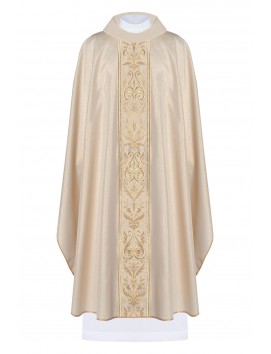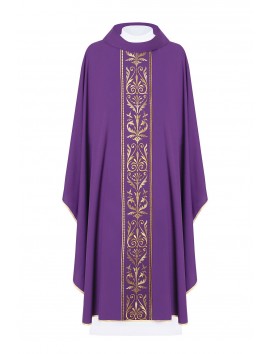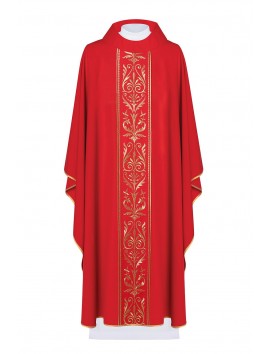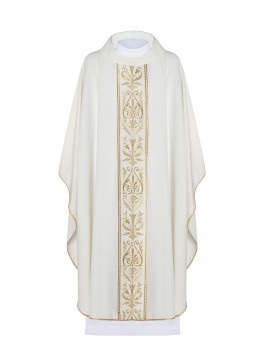The colors of a priest's vestments can vary depending on the liturgical season or occasion. Here is a brief explanation of the meaning of the most common colors:
- White: White is the color of purity and joy and is used during the Christmas and Easter seasons, as well as feasts of the Lord, the Blessed Virgin Mary, and the angels.
- Red: Red is the color of blood and fire and symbolizes martyrdom, sacrifice, and the Holy Spirit. It is used on Palm Sunday, Good Friday, Pentecost, and feasts of martyrs and apostles.
- Green: Green is the color of life and growth and is used during Ordinary Time, the period between Christmas and Lent, and between Easter and Advent.
- Purple/Violet: Purple or violet is the color of penance and preparation, and is used during Advent and Lent, as well as other penitential seasons and days.
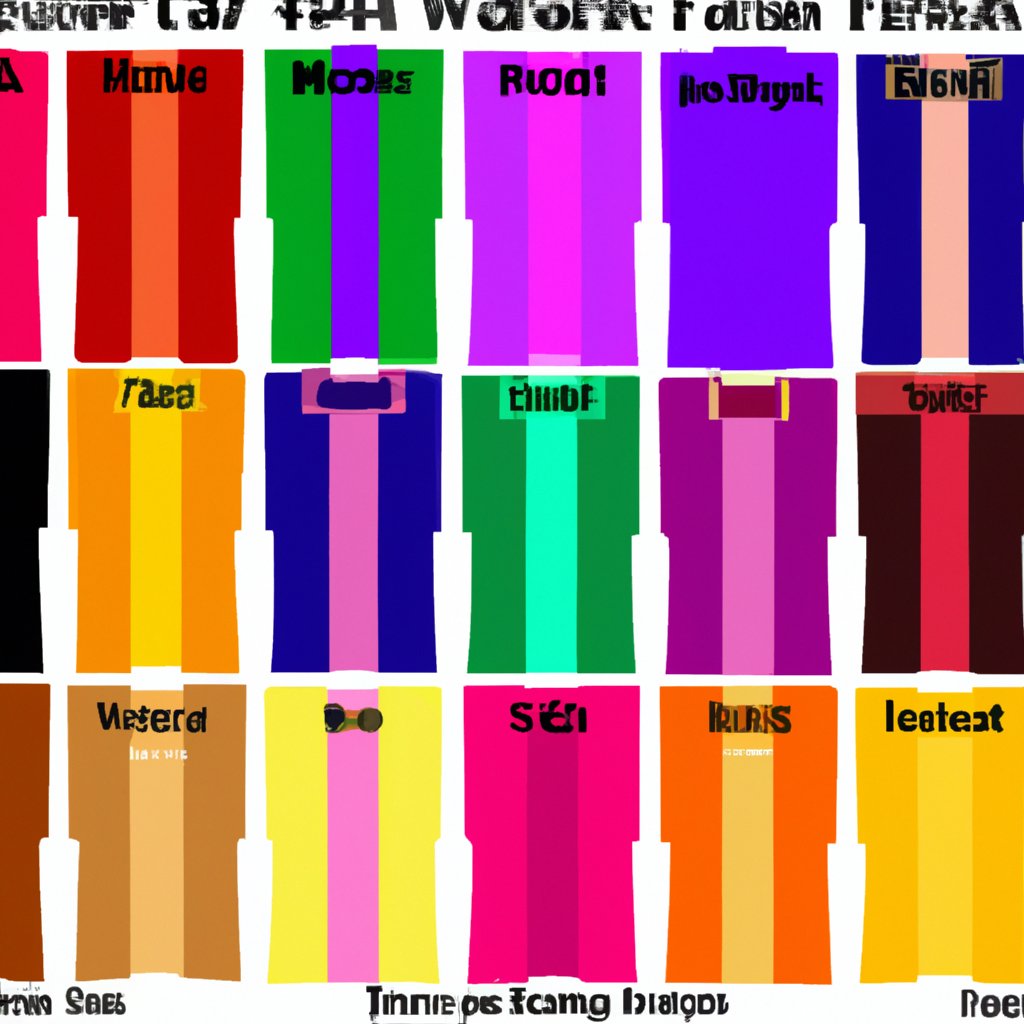
What are the colors of vestments?
The colors of vestments used in the Catholic Church can vary depending on the liturgical season or occasion. The most common colors are
1. White - symbolizes purity, innocence, and joy. It is used during the Christmas and Easter seasons, as well as for feasts of the Lord, the Blessed Virgin Mary, and the angels.
2. Red - symbolizes blood, fire and the Holy Spirit. It is used on Palm Sunday, Good Friday, Pentecost, and the feasts of Martyrs and Apostles.
3. Green - symbolizes life and hope. It is used during Ordinary Time, the period between Christmas and Lent, and between Easter and Advent.
4. Purple/Violet - symbolizes repentance and preparation. It is used during Advent and Lent, as well as other penitential seasons and days.
5. Rose/Pink - symbolizes joy and rejoicing in the midst of penance. It is used on the third Sunday of Advent, called Gaudete Sunday.
What are the 5 Colours of the vestment robes?
The five colors of vestments used in the Catholic Church are: white, red, green, purple/violet, and rose/pink. White symbolizes purity, innocence, and joy and is used during the Christmas and Easter seasons, as well as feasts of the Lord, the Blessed Virgin Mary, and the angels. Red symbolizes blood, fire, and the Holy Spirit and is used on Palm Sunday, Good Friday, Pentecost, and the feasts of Martyrs and Apostles. Green symbolizes life and hope and is used during Ordinary Time. Purple/Violet symbolizes penance and preparation and is used during Advent and Lent, as well as other penitential seasons and days. Rose/pink symbolizes joy and rejoicing in the midst of penance and is used on the third Sunday of Advent, called Gaudete Sunday, and on the fourth Sunday of Lent, called Laetare Sunday.
What do priest robe colors mean?
The colors of priestly vestments, also known as vestments, used in the Catholic Church have symbolic meanings. The colors help to reflect the mood of the liturgical season or occasion, and they also symbolize different aspects of the faith. Here are the meanings of the most common colors:
1. White - symbolizes purity, innocence, and joy. It is used during the Christmas and Easter seasons, as well as for feasts of the Lord, the Blessed Virgin Mary, and the angels.
2. Red - symbolizes blood, fire and the Holy Spirit. It is used on Palm Sunday, Good Friday, Pentecost, and the feasts of Martyrs and Apostles.
3. Green - symbolizes life and hope. It is used during Ordinary Time, the period between Christmas and Lent, and between Easter and Advent.
4. Purple/Violet - symbolizes repentance and preparation. It is used during Advent and Lent, as well as other penitential seasons and days.
What do different color robes mean Catholic priests wear?
The different colors of the vestments worn by Catholic priests during liturgical celebrations have symbolic meanings. Here are the meanings of the most common colors:
1. White - symbolizes purity, innocence, and joy. It is used during the Christmas and Easter seasons, as well as for feasts of the Lord, the Blessed Virgin Mary, and the angels.
2. Red - symbolizes blood, fire and the Holy Spirit. It is used on Palm Sunday, Good Friday, Pentecost, and the feasts of Martyrs and Apostles.
3. Green - symbolizes life and hope. It is used during Ordinary Time, the period between Christmas and Lent, and between Easter and Advent.
4. Purple/Violet - symbolizes repentance and preparation. It is used during Advent and Lent, as well as other penitential seasons and days.
5. Rose/Pink - symbolizes joy and rejoicing in the midst of penance. It is used on the third Sunday of Advent, called Gaudete Sunday.
What color is the priests chasuble?
The color of the priest's chasuble, the outermost liturgical vestment worn during the celebration of Mass in the Catholic Church, can vary depending on the liturgical season or occasion. Here are the colors and their significance:
1. White - worn during the Christmas and Easter seasons, as well as on feasts of the Lord, the Blessed Virgin Mary, and the angels. It symbolizes purity, innocence, and joy.
2. Red - worn on Palm Sunday, Good Friday, Pentecost, and feasts of martyrs and apostles. It symbolizes blood, fire, and the Holy Spirit.
3. Green - worn during Ordinary Time, which is the period between Christmas and Lent, and between Easter and Advent. It symbolizes life and hope.
4. Purple/Violet - worn during Advent and Lent, as well as other penitential seasons and days. It symbolizes repentance and preparation.
5. Rose/Pink - worn on the third Sunday of Advent.
What do red vestments signify?
In the Catholic Church, red vestments are worn by priests during certain liturgical celebrations, such as Palm Sunday, Good Friday, Pentecost, and the feasts of the Martyrs and Apostles. The color red symbolizes several things, including blood, fire, and the Holy Spirit.
Red is associated with the Holy Spirit because at Pentecost, the apostles received the Holy Spirit in the form of tongues of fire. Red is also associated with the blood of martyrs who gave their lives for the faith. For this reason, red vestments are worn on the feasts of the martyrs and apostles.
Furthermore, red is a vibrant and attention-grabbing color, which is why it is used during solemn and important liturgical celebrations. It reminds the faithful of the sacrifice of Christ and the courage of those who gave their lives for the faith.
What does a red Catholic robe mean?
In the Catholic Church, the red robe is called a cassock. It is a long, ankle-length garment worn by the clergy, including priests, bishops, and cardinals. The cassock is a symbol of their role as members of the clergy and their commitment to serve God and the Church.
The color red, when used in the context of a cassock, has different meanings depending on the context. In some cases, a red cassock may be worn by a cardinal, signifying his rank as a prince of the Church. Cardinals are the highest-ranking members of the Catholic Church after the Pope, and the red cassock is a symbol of their authority and service to the Church.
In other cases, a red cassock may be worn by a priest during certain liturgical celebrations, such as Palm Sunday or Good Friday. The color red symbolizes blood, fire, and the Holy Spirit, and reminds the faithful of the sacrifice of Christ and the courage of those who gave their lives for the faith.
What does the color red mean on a priest stole?
In the Catholic Church, the stole is a long, narrowband of cloth worn by the clergy, including priests, deacons, and bishops. Its color may vary according to the liturgical season or occasion. When the color red is used on a priest's stole, it signifies several things.
Red is the color of blood, fire, and the Holy Ghost. It is a symbol of sacrifice, martyrdom, and the courage of those who have given their lives for the faith. In this sense, a red stole may be worn during Lent, Holy Week, or on the feasts of martyrs and apostles.
Red is also associated with the celebration of the Holy Spirit, since it was at Pentecost that the apostles received the Holy Spirit in the form of tongues of fire. For this reason, a priest may wear a red stole during the celebration of Pentecost.
Finally, a red stole may be worn during certain sacramental celebrations that involve the Holy Spirit, such as the sacrament of Confirmation.
What is red chasuble for?
In the Catholic Church, the chasuble is a sleeveless outer vestment worn by the priest during liturgical celebrations such as Mass. The color of the chasuble may vary depending on the liturgical season or occasion. When the color red is used on a chasuble, it signifies several things.
Red is the color of blood, fire, and the Holy Spirit. It is a symbol of sacrifice, martyrdom, and the courage of those who have given their lives for the faith. In this sense, a red chasuble may be worn during Lent, Holy Week, or on the feasts of martyrs and apostles.
Red is also associated with the celebration of the Holy Spirit, since it was at Pentecost that the apostles received the Holy Spirit in the form of tongues of fire. For this reason, a priest may wear a red chasuble during the celebration of Pentecost.
Why do priests wear green?
In the Catholic Church, green is one of the liturgical colors used for vestments worn by priests during certain liturgical seasons and occasions. The color green is used to signify hope, growth, and new life. Priests wear green vestments during Ordinary Time, which is the longest liturgical season in the Catholic Church outside of major seasons such as Advent, Christmas, Lent, and Easter. Ordinary Time is a time of growth and reflection on the life and teachings of Jesus Christ.
The color green is also used during some other liturgical celebrations, such as the Feast of the Holy Trinity and the Feast of Christ the King. In these cases, the color green is used to symbolize the hope and new life that comes from our faith in God and the teachings of Jesus Christ.
It's worth noting that the use of liturgical colors is not limited to the Catholic Church, and may vary among different Christian traditions. However, the symbolism and meaning behind each color generally remain consistent across traditions.
What does a green chasuble mean?
In the Catholic Church, the chasuble is a type of vestment worn by priests during liturgical celebrations such as Mass. The color of the chasuble can vary depending on the liturgical season or occasion. When the color green is used on a chasuble, it indicates the liturgical season of Ordinary Time.
Ordinary Time is a time of growth and reflection on the life and teachings of Jesus Christ. The color green is used to symbolize hope, renewal and growth. During Ordinary Time, the Church focuses on the teachings of Christ and how to live those teachings in our daily lives.
The use of green on the chasuble during Ordinary Time reminds the faithful that we are called to grow in our faith and live out the teachings of Christ in our daily lives. It is a time to reflect on the many ways in which we can continue to grow in our relationship with God and with one another.
What does a green priest robe mean?
The green vestment worn by priests during liturgical celebrations is called a chasuble. In the Catholic Church, a green chasuble is worn during the liturgical season of Ordinary Time. Ordinary Time is the longest liturgical season in the Catholic Church and occurs twice in the liturgical year, outside the major liturgical seasons of Advent, Christmas, Lent, and Easter. The color green is used during Ordinary Time to symbolize hope, renewal, and growth. It is a time for the faithful to focus on the teachings of Christ and how to live those teachings in our daily lives. The green chasuble worn by priests is a visual reminder of these themes and encourages the faithful to reflect on how we can continue to grow in our relationship with God and one another.
What does a purple stole mean priest?
In the Catholic Church, a purple stole worn by a priest signifies the liturgical season of Advent or Lent. Advent is the season of preparation for the celebration of the birth of Jesus Christ at Christmas, while Lent is the season of preparation for the commemoration of the passion, death, and resurrection of Jesus Christ at Easter.
Purple is a color often associated with penance, preparation, and solemnity, all of which are themes present during these seasons. During Advent, the purple stole serves as a reminder of the need for repentance and a call to prepare for the coming of Christ. During Lent, the purple stole symbolizes the penitential nature of the season and the need for self-examination and spiritual renewal.
The stole is a long, narrow, scarf-like garment worn by the priest over his shoulders, symbolizing the authority and responsibility of his priestly ministry.
What does a violet chasuble mean?
In the Catholic Church, a violet chasuble is worn by priests during the liturgical seasons of Advent and Lent, as well as on certain solemnities and feasts. The color violet is associated with penance, preparation and anticipation. It is a color that helps the faithful to focus on the spiritual aspect of these liturgical seasons and to reflect on their own need for repentance, renewal and conversion.
During Advent, the violet chasuble is a visual reminder of the need to prepare our hearts and minds for the coming of Christ at Christmas. It is a time of prayer, fasting, and almsgiving as we anticipate the birth of our Savior.
During Lent, the purple chasuble symbolizes the penitential and introspective nature of the season. It is a time of spiritual renewal, self-examination, and conversion as we prepare to celebrate the resurrection of Jesus Christ at Easter.
What does the color pink mean on a priest's stole?
In the Catholic Church, the color pink or rose is used on a priest's stole on the Third Sunday of Advent and the Fourth Sunday of Lent. These Sundays are known as Gaudete Sunday and Laetare Sunday, respectively. The use of pink or rose is meant to signify a sense of joy and rejoicing in the midst of the penitential seasons of Advent and Lent.
Gaudete Sunday, which means "rejoice" in Latin, is a time of celebration as we approach the birth of Jesus at Christmas. The pink or rose stole worn by the priest serves as a visual reminder of the joy that comes with the anticipation of Christ's birth.
Similarly, Laetare Sunday, which means "rejoice" in Latin, is a time of celebration in the midst of the penitential season of Lent. The pink or rose stole worn by the priest on this day is a reminder that even in the midst of our sacrifices and penance during Lent, there is still reason to rejoice in the hope of Christ's resurrection.
What does the white chasuble mean?
In the Catholic Church, the white chasuble is worn by the priest during the Christmas and Easter seasons, as well as on feast days and celebrations of the Lord, the Blessed Virgin Mary, and non-martyred saints. It is the color of joy, purity, innocence and light. White is also the traditional color worn by priests at weddings and baptisms, symbolizing the new life and grace that these sacraments bring.
During the Christmas season, the white chasuble is worn to celebrate the birth of Jesus Christ, the light of the world, while during the Easter season it is worn to celebrate the resurrection of Christ, the triumph of light over darkness and death.
Overall, the white chasuble is a visual reminder of the joy and hope that accompany the celebration of the most significant events in the life of Christ and the Church. It is a symbol of the radiance and glory of God's presence among us.
Why did Father Paul wear the gold chasuble?
Gold is a liturgical color symbolizing majesty, royalty, and the glory of God. It is believed to reflect the radiance of the divine presence and the splendor of heaven. Gold is also associated with the gifts of the Magi to the infant Jesus, which represent Christ's kingship, priesthood, and sacrifice.
Therefore, Father Paul may have worn a gold chasuble for a special event, like a solemn Mass, ordination, or a celebration of a significant feast or anniversary. It could also be a personal preference or a tradition in his parish or religious community.

